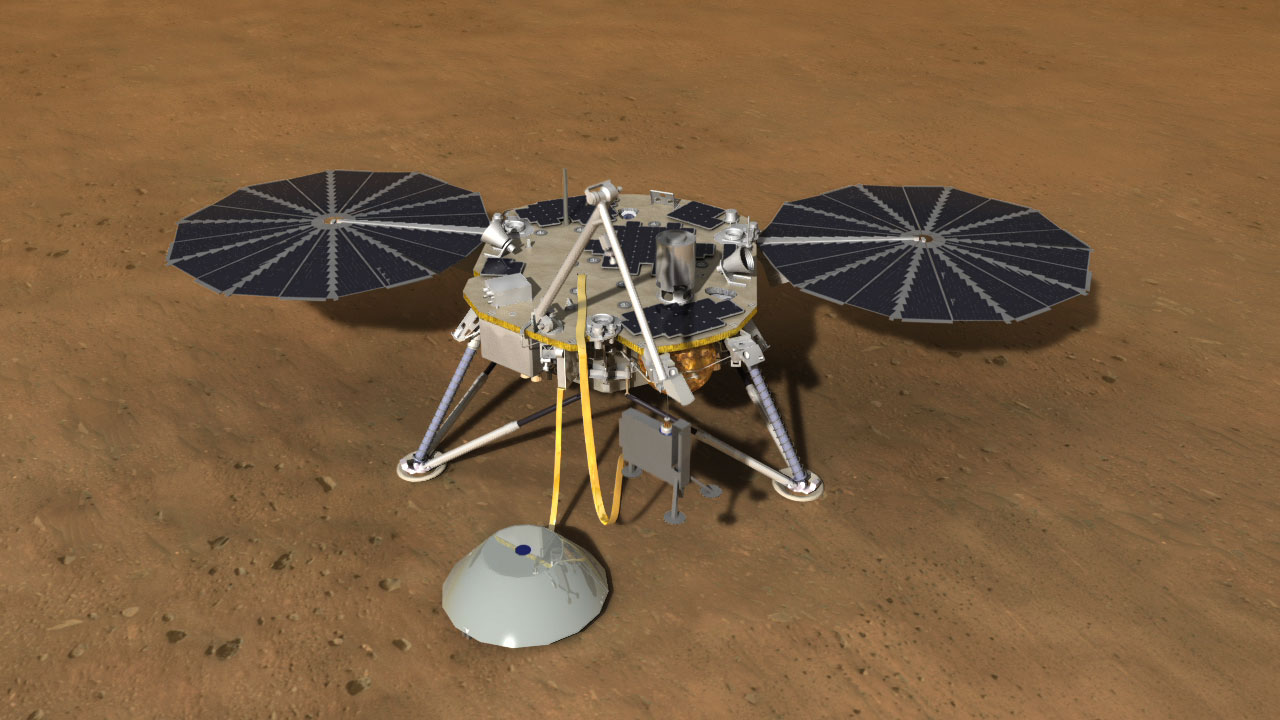NASA's InSight Lander Will Look Inside Mars Like Never Before. Here's Why.
On Monday (Nov. 26), Mars fans around the globe will watch eagerly to see NASA land a new mission called InSight on the Red Planet — but for the scientists who built the mission, the real excitement will just be getting started.
That's because the $850 million InSight mission has an ambitious slate of scientific tasks to accomplish during its time at work on the surface, which is planned to last about two years. While plenty of orbiters, landers and rovers have sought to understand Mars' surface and atmosphere, InSight — or more formally Interior Exploration using Seismic Investigations, Geodesy and Heat Transport — will be the first to turn its gaze inward.
With just three main instruments aboard the lander, the team has carefully designed the mission to tackle a big mystery: What's hiding beneath the Martian surface — geologically, that is. That makes InSight stand out from the string of missions that have gradually looked at the possibility of life on Mars throughout the planet's history, most recently the Curiosity rover and the upcoming Mars 2020 rover. [NASA's InSight Mars Lander: Full Coverage]
InSight has three main projects that will structure its time on Mars.
First, it carries a seismometer decked out with a suite of environmental sensors. You may be familiar with seismometers from their work here on Earth detecting tremors in the ground, and InSight's will perform a similar task, sensing hypothesized shakes in the ground that scientists call marsquakes, as well as tremors triggered by meteorite impacts.
But terrestrial seismometers build up a dense network of instruments, helping scientists pinpoint what's causing the shakes those instruments feel. InSight's seismometer will be the only quake sense on all of Mars, so scientists had to rig the instrument to make sure they could still get the data they need. They'll also be hoping to see as many shakes as possible to maximize the data they can use and its precision.
Another challenge for the seismometer was eliminating all the other factors that could look like shakes to the super-sensitive instrument. That means the seismometer is decked out with a suite of sensors measuring factors like wind and pressure, which could be misinterpreted as marsquakes.
Breaking space news, the latest updates on rocket launches, skywatching events and more!
Once the seismometer has time to gather data on shakes, the team hopes to be able to map layers within Mars, since waves travel differently through rock under different conditions. The analysis could also potentially identify liquid water or plumes feeding volcanoes, although scientists aren't yet confident of that.
That underground-mapping project is paralleled by the work being done by a second instrument, a pair of incredibly precise radio transmitters. By bouncing signals to and from Earth and watching how they travel, scientists can identify where InSight is in space down to just a couple inches (a few centimeters).
Using that ultra-detailed location, the scientists can then watch the lander move over time and gradually map the tiny wobbles in how Mars rotates. Those wobbles reflect the planet's interior structure, specifically where its core falls on the spectrum between solid and liquid — the latter sloshes more.
InSight's final task is to deploy a heat probe that can hammer itself 16 feet (5 meters) below the Martian surface — much deeper than the mere inches that other spacecraft have drilled on planetary bodies.
The probe will measure how heat is rising through the planet, which should help scientists figure out where the heat is coming from. It can also produce its own brief flashes of heat and study how that heat flows through the surrounding rock, learning more about the rock that makes up the Martian crust.
All told, InSight's three projects will help scientists figure out how our neighbor was born and whether Mars was formed from the same mixture of materials as Earth and our moon. That could have implications for our broader understanding of how our solar system formed — and even for what we know about solar system formation more generally.
So get excited for the drama of landing — but remember, it's just the beginning for InSight.
Email Meghan Bartels at mbartels@space.com or follow her @meghanbartels. Follow us @Spacedotcom and Facebook. Original article on Space.com.

Meghan is a senior writer at Space.com and has more than five years' experience as a science journalist based in New York City. She joined Space.com in July 2018, with previous writing published in outlets including Newsweek and Audubon. Meghan earned an MA in science journalism from New York University and a BA in classics from Georgetown University, and in her free time she enjoys reading and visiting museums. Follow her on Twitter at @meghanbartels.

